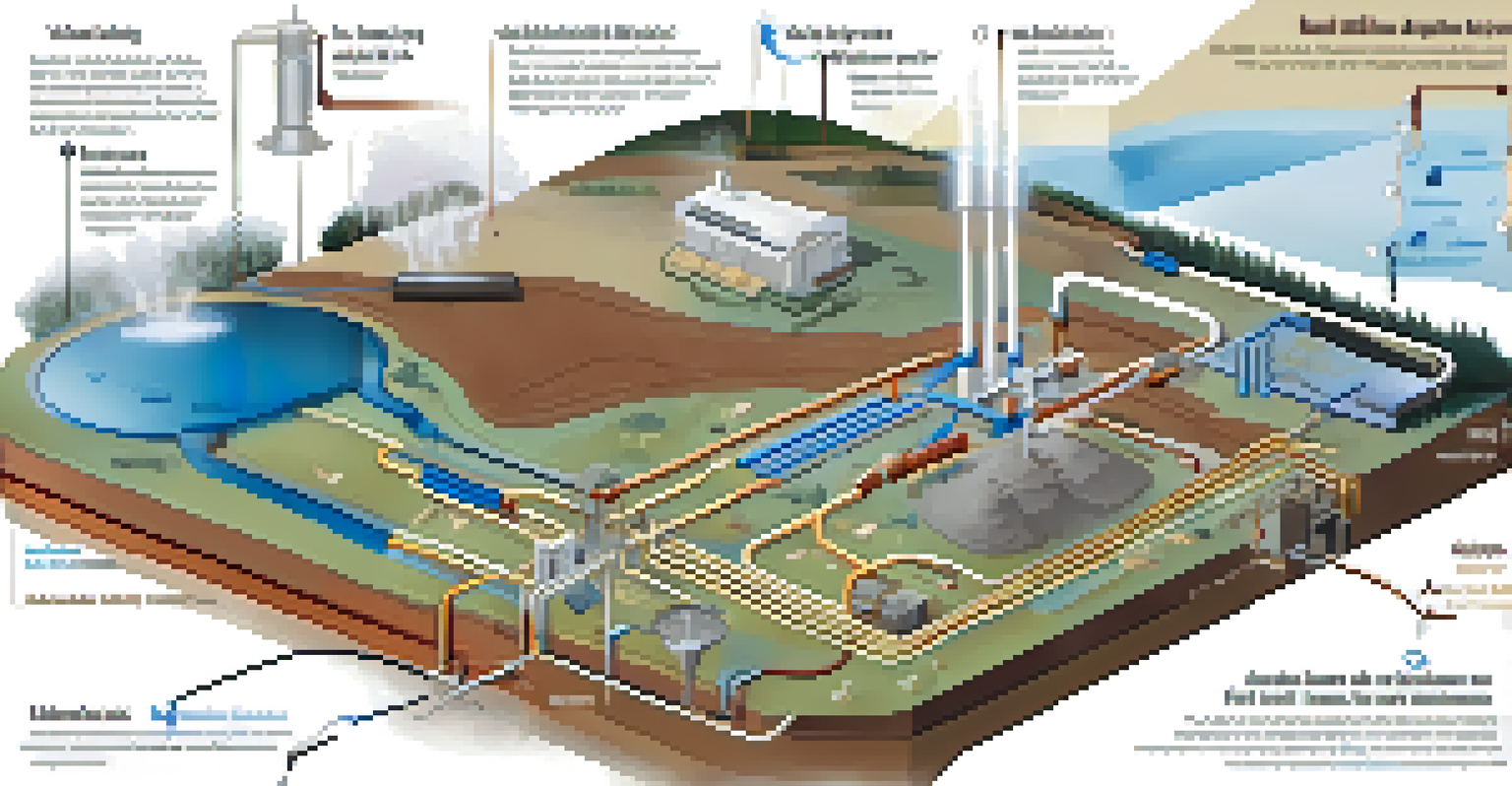Exploring the Use of Geothermal Energy in Construction

Understanding Geothermal Energy Basics
Geothermal energy harnesses heat from the Earth’s core, providing a sustainable energy source. This process involves tapping into underground reservoirs of steam and hot water, which can be used for heating and electricity generation. Unlike fossil fuels, geothermal energy produces minimal greenhouse gas emissions, making it an eco-friendly choice for various applications, including construction.
Geothermal energy is the energy derived from the heat stored beneath the earth's surface. It is a sustainable and renewable source of energy that can be tapped into for heating and electricity generation.
To illustrate, think of geothermal energy like a heat sponge: the Earth absorbs solar energy, storing it deep within, ready to be used when needed. This stored energy can be tapped into with the right technology, making it a reliable and constant energy source. It’s not just about harnessing heat; it’s about utilizing a resource that’s abundantly available beneath our feet.
In construction, understanding these basics allows builders and developers to integrate geothermal systems into their projects effectively. This can lead to significant energy savings and a reduced carbon footprint, benefiting both the environment and the bottom line.
Benefits of Geothermal Energy in Construction
The advantages of using geothermal energy in construction are numerous and compelling. First and foremost, it can drastically lower energy costs over time, as geothermal systems require less energy to operate compared to traditional heating and cooling systems. This results in significant savings for homeowners and businesses alike, making it an appealing option for budget-conscious projects.

Moreover, geothermal energy enhances energy efficiency, which is increasingly important in today's environmentally conscious market. By using the Earth's natural heat, buildings can maintain stable indoor temperatures while minimizing energy consumption. This not only contributes to sustainability but also creates a more comfortable living or working environment.
Geothermal Energy Benefits Construction
Integrating geothermal energy can significantly lower energy costs and enhance property value while promoting sustainability.
Finally, incorporating geothermal energy into construction projects can lead to increased property value. Buyers and tenants are often attracted to energy-efficient homes and buildings, especially those with lower utility bills. In this way, geothermal energy not only supports environmental goals but also aligns with economic interests.
How Geothermal Systems Work in Buildings
Geothermal systems primarily operate through heat pumps, which transfer heat between the building and the ground. The system consists of a ground loop, heat pump, and distribution system, all working together to provide heating and cooling. During winter, the heat pump extracts heat from the ground, while in summer, it reverses the process, cooling the building by transferring heat back into the ground.
The future of geothermal energy is bright, as it offers a reliable and environmentally friendly solution to meet our energy needs while reducing our carbon footprint.
Think of it like a well-oiled machine that efficiently manages the temperature of your home. The ground loop, buried underground, acts as a constant temperature reservoir, making it easier for the heat pump to extract or dissipate heat. This not only enhances efficiency but also prolongs the lifecycle of the HVAC system.
Understanding this process is crucial for construction professionals looking to implement geothermal energy. By effectively designing and installing these systems, they can ensure optimal performance, leading to a more sustainable and cost-effective building.
Challenges in Implementing Geothermal Energy
While the benefits of geothermal energy in construction are clear, there are challenges that developers may face. One of the primary hurdles is the initial cost of installation, which can be higher than traditional systems. This upfront investment can deter some builders, especially when tight budgets are a concern.
Additionally, the suitability of geothermal systems can vary based on geographic location. Not all areas have the same access to underground heat resources, and local geology can impact the efficiency of geothermal systems. Conducting thorough site assessments is essential to determine if geothermal energy is a viable option for a specific project.
Challenges in Adoption Persist
High initial installation costs and varying geographic suitability can deter some developers from choosing geothermal solutions.
Despite these challenges, many developers find that the long-term benefits outweigh the initial costs. With proper planning and research, geothermal energy can be successfully integrated into construction projects, paving the way for a more sustainable future.
Case Studies of Successful Geothermal Projects
Examining real-world examples can provide valuable insights into the practical applications of geothermal energy. For instance, a notable project in the Pacific Northwest utilized geothermal heat pumps to significantly reduce energy consumption in a multi-family housing complex. This project not only lowered utility costs but also received accolades for its sustainable design.
Another inspiring case study comes from Iceland, where geothermal energy is a key component of the country's infrastructure. Almost 90% of homes in Iceland are heated using geothermal systems, showcasing the potential of this energy source. This widespread adoption has led to a dramatic reduction in carbon emissions, establishing Iceland as a leader in sustainable energy.
These examples illustrate that, when implemented thoughtfully, geothermal energy can transform construction projects into models of sustainability. By learning from these successes, other builders and developers can be inspired to explore geothermal solutions in their own projects.
Future Trends in Geothermal Energy for Construction
As we look to the future, the role of geothermal energy in construction is expected to expand significantly. Innovations in technology are making geothermal systems more efficient and cost-effective than ever before. For example, advancements in drilling techniques are allowing for deeper and more efficient geothermal wells, unlocking new potential for energy extraction.
Additionally, the growing movement towards sustainable building practices is pushing more developers to consider geothermal energy. As regulations around carbon emissions tighten and public demand for eco-friendly solutions increases, geothermal energy is poised to become a popular choice for new construction projects.
Future Innovations in Geothermal Tech
Advancements in technology and a growing emphasis on sustainable practices are expected to drive the adoption of geothermal energy in future construction projects.
By staying informed about these trends, construction professionals can position themselves at the forefront of the industry. Embracing geothermal solutions not only aligns with market demands but also contributes to a more sustainable world.
Getting Started with Geothermal Energy in Your Projects
For builders and developers interested in integrating geothermal energy into their projects, the first step is to conduct a feasibility study. This involves assessing the site’s geology, soil conditions, and available resources to determine the best type of geothermal system to implement. Consulting with experts in the field can streamline this process and provide valuable insights.
Next, it’s crucial to collaborate with qualified professionals for the design and installation of the geothermal system. This includes working with engineers and contractors who specialize in geothermal technology to ensure that the system is tailored to the specific needs of the building. A well-designed system can maximize efficiency and longevity.

Finally, educating clients and stakeholders about the benefits of geothermal energy can help garner support for its implementation. By highlighting long-term savings, environmental impact, and increased property value, builders can make a compelling case for this sustainable energy solution.